There’s a reason Julie Andrews didn’t sing about data analysis instead of whiskers on kittens and raindrops on roses. Those things are nostalgic happiness generators. Flowers and kittens give everyone warmth and fuzzies (unless you’re allergic to cats).
Alas, for most website owners, the only thing the words “content audit” evokes is a shiver down the spine. That’s probably why our beloved Sound of Music heroine didn’t add data and spreadsheets to her list of favorite things. Yep. That’s the reason.
Nonetheless, content auditing is a necessary evil. We’ve long known it’s an integral part of content management, and a big step toward hosting a successful website. Conducting regular content audits isn’t simply a nice thing to do; it’s something you absolutely need to do if you’re looking to improve your website’s success (and your content performance) for the year ahead. And what better time to do that than right now?
Luckily, we’ve got you covered!
We want to make content auditing an experience that is as seamless and enjoyable as possible. Therefore, our step-by-step guide to performing the comprehensive content audit of your dreams — one that will help you meet all your content goals so you can focus your time and attention on raindrops, kittens, and all the rest of your favorite things.
Peace out, dog bites and bee stings.
What Is A Content Audit?
A content audit is a review of all the pieces of content on your website, from blog posts and landing pages to product pages and informational pages.
The content audit process helps you create a comprehensive list or inventory of all the content assets on your site, which you can then analyze to make informed decisions about which content pieces to update, keep as is, consolidate, remove, or create.
What Purpose Does A Content Audit Serve?
Auditing your site’s content is a bit like maintaining your vehicle. In order to run at its best, it needs routine maintenance: oil changes, tire rotations, and occasional fixes for parts that reach the end of their lifespan. Your website, and especially your content, is the same way. When you first publish a blog post, it’s shiny and new, like a brand new car. But over time, its internal links go to 404s. It falls down the SERPs. Its organic traffic drops off. It’s still a good blog post, but it needs a little maintenance — a content audit.
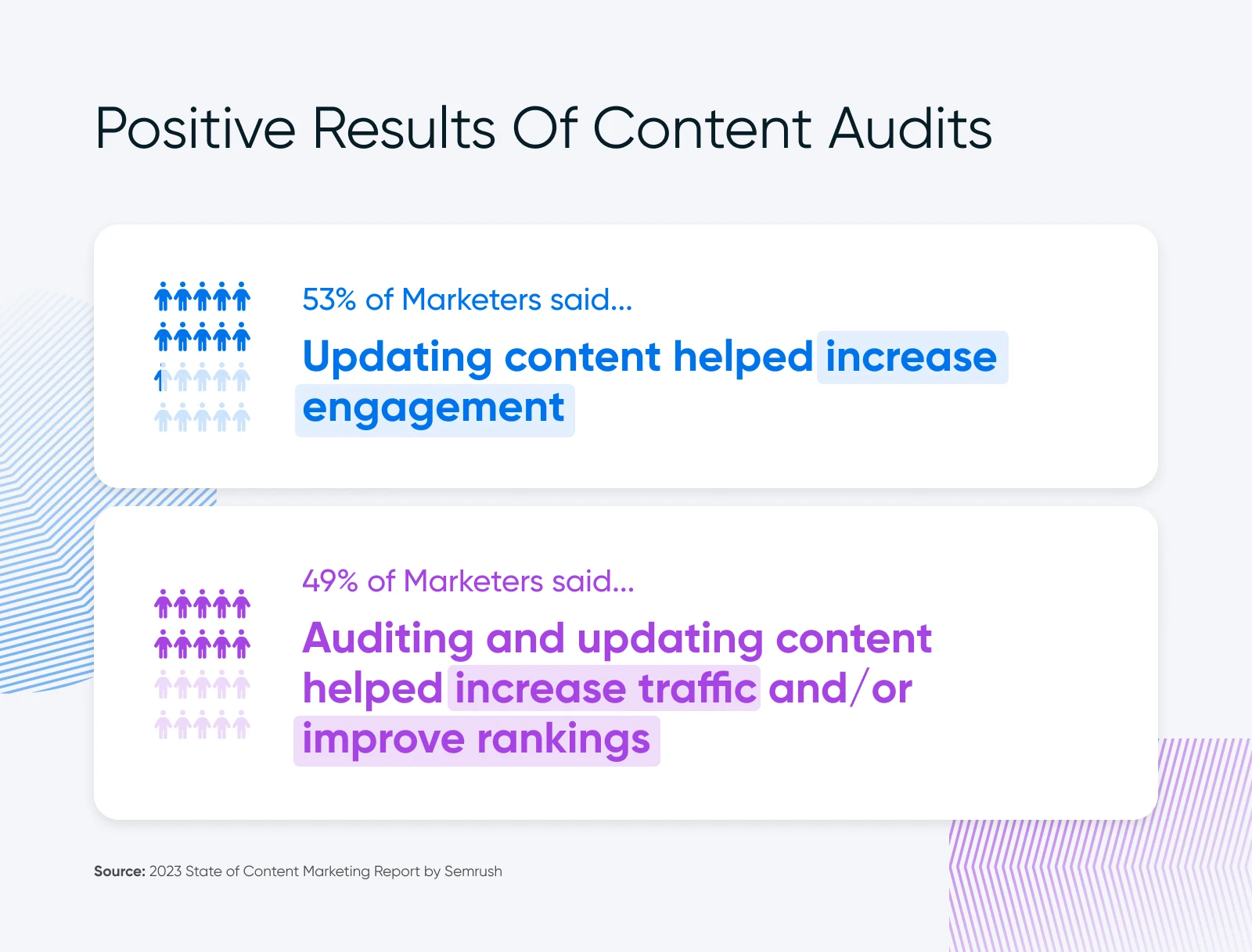
According to Semrush’s 2023 State of Content Marketing Report, 53% of marketers said updating their content helped increase their engagement. 49% said auditing and updating content helped them increase their traffic and/or improve their rankings.
Clearly, there are a lot of potential benefits in store if you make auditing a part of your ongoing content strategy.
Content auditing can help you:
- Create a thorough inventory of content from your site and understand how it all performs.
- Identify gaps in your content, including types of content or specific content formats you could offer to meet your audience’s needs.
- Make informed decisions about how to improve your content over time to align your content marketing efforts with your larger business goals.
- Identify content issues you can resolve (such as removing duplicate or outdated content).
- Identify and improve underperforming content.
- Improve your site’s SEO performance through your content efforts.
- Make your site easy for visitors to navigate by keeping content relevant and error-free.
- Identify high-quality content you can repurpose for other materials, like marketing campaigns or social media posts.
- Determine the content types your audience likes and dislikes so you can create content that is most likely to resonate with your visitors and customers.
- Assess your content for digital accessibility and make improvements so it meets current accessibility standards.
Before You Start A Content Audit
Before we initiate the Operation Step-by-Step Guide, it’s important to assess a few aspects of your site to determine what kind of audit to perform (and why) — and whether you need a content audit in the first place.
There are two closely related marketing efforts that require content audits: search engine optimization (SEO) and content marketing. If you employ either of these tactics, then performing a content audit is likely to benefit you and your business.
SEO
Search Engine Optimization (SEO) is the practice of improving a site’s ranking in search results. Search results are aggregated based on a number of factors, including a site’s relevance and quality. Optimizing your site for these factors can help boost your rankings.
Read MoreThat’s because gathering a big-picture view of all of your content elements (like URLs, keywords and phrases, word counts, etc.) will allow you to see how you can better grow your organic traffic. Plus, when you revise or improve your content based on your findings, you’re likely to get an SEO bump in addition to creating something that resonates more with your audience.
Now, one last thing before we plunge into the nitty-gritty stuff. A content audit isn’t a 10-minute project.
It’s a time-consuming process and requires a good deal of analytics and brain power. As the old adage goes, don’t bite off more than you can chew. Make sure you have the resources and time to tackle this project. But know that the rewards will be well worth the effort.
Short on time? Scroll to the bottom of the post for a quick trick that can help until you have the time and resources for a comprehensive audit.
The 6 Steps For A Successful Content Audit
Now that you know what a content audit is, and why you should make regular audits a part of your SEO and content marketing strategy, it’s time to dive into the process. The six steps below represent a basic content audit workflow, but keep in mind that this is just a jumping-off point. You may find there are ways to tweak this process to make it better suit your business objectives. Regardless, these steps are a great place for any business to start.
1. Define Your Goals And Metrics
Before actually plunging into your content library, the first and perhaps most crucial step is to anchor yourself with a clear set of goals. What do you hope to achieve with this content audit?
By defining clear goals and tracking specific metrics, you ensure your content audit will be more focused, actionable, and ultimately more successful in improving your website’s performance and user experience.
The goal you set for your content audit should be specific to your business goals and current content needs.
Below are a few examples of some goals a content audit can help you achieve and the metrics you would track for each one.
Goal 1: Improve SEO Performance
An SEO audit identifies SEO opportunities by highlighting low-quality content, outdated SEO practices, and gaps in keyword coverage. It gives you a bird’s eye view of where and how your content can be optimized to meet the latest search engine algorithms and user search behaviors.
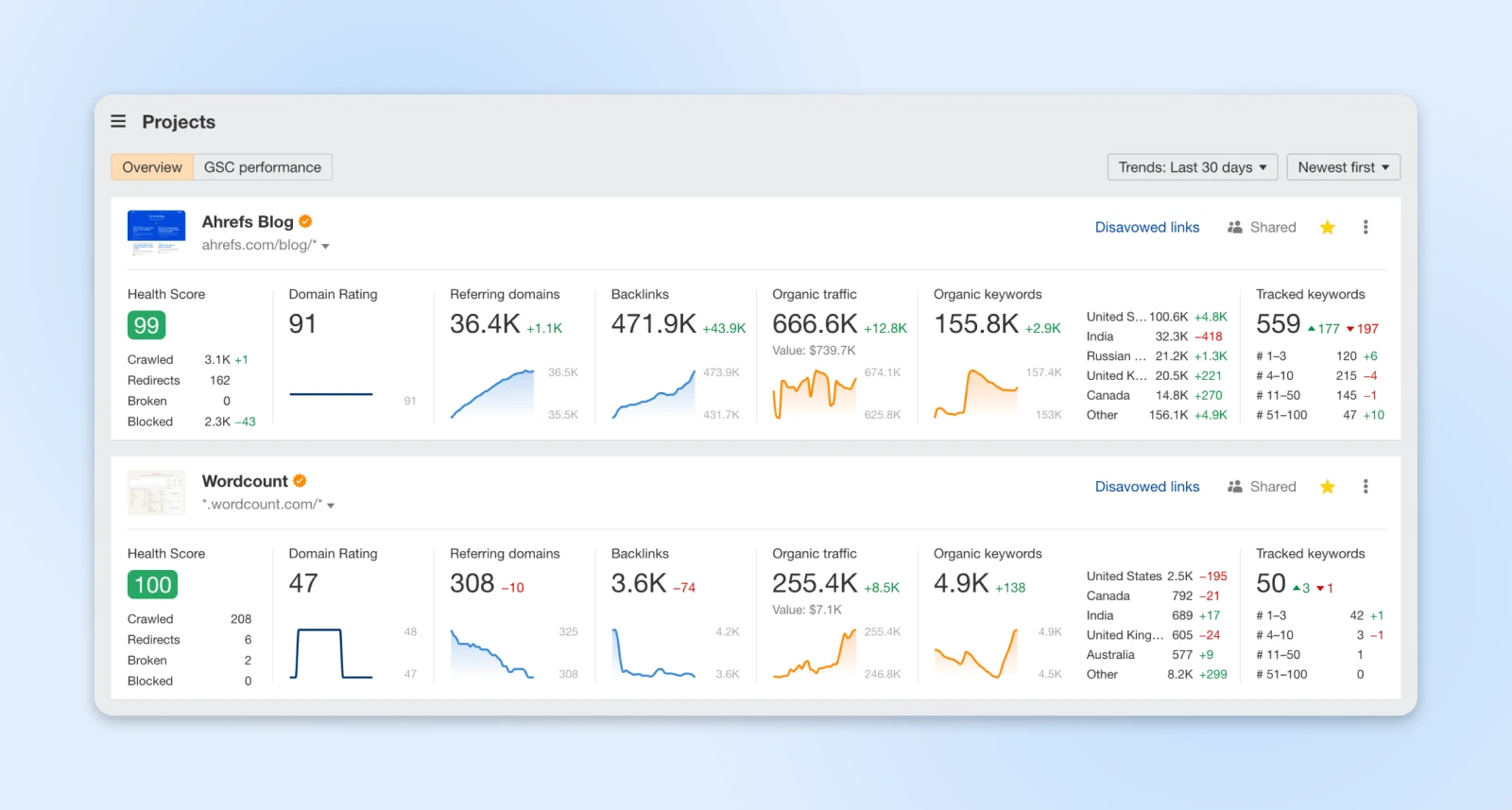
Tactics to use:
- Keyword optimization: Reassess the keywords each piece of content targets, ensuring they align with current search trends and user intent. Update content to include relevant, high-volume keywords.
- Content refreshes: Optimize headings, title tags, meta titles, and descriptions for better SERP visibility. Organize your content structure in a way that search engines can easily crawl and understand.
- Link health audit: Analyze internal and external links for relevance and functionality. Remove or replace broken links and identify new internal linking opportunities to enhance SEO connectivity.
Metrics to track:
- Organic traffic: The number of visitors coming to your site through search engines
- Keyword rankings: Where your web pages rank on search engine results pages (SERPs) for specific keywords
- Backlinks: The number and quality of external sites linking back to your content
Goal 2: Enhance User Engagement
Engagement metrics provide insights into how users interact with your content, which can help tailor your content strategy to meet user needs more effectively. A content audit can uncover which pieces of content resonate most with your audience and why. By understanding the characteristics of high-engagement content, you can replicate these qualities in future content, improving overall user engagement across your site.
Tactics to use:
- Content refreshes: Evaluate how your content is presented. Break up large blocks of text with headings, bullet points, and images to improve readability and engagement
- Multimedia: Identify opportunities to add or enhance multimedia elements like videos, infographics, and interactive content that can increase time on page and engagement
- Personalization: Consider ways to make content more relevant to different segments of your audience, possibly through personalization or creating more targeted content paths
Metrics to track:
- Bounce rate: The percentage of visitors who leave your site after viewing only one page, indicating the relevance and engagement level of your content
- Pageviews: The total number of pages viewed, reflecting the breadth of content consumption
- Average time on page: How long visitors stay on a page, offering clues about the content’s engagement and value
Goal 3: Increase Content Relevance and Quality
Auditing your site can help you identify outdated, inaccurate, low-quality, or duplicate content that needs updating or removal. This helps make sure your audience finds value in every piece of content they come across, which can increase trust and authority for your site and brand.

Tactics to use:
- Content refreshes: Update statistics, references, and examples in older posts to reflect current information and trends. This can also include enhancing the depth and quality of analysis
- User feedback: Actively seek and incorporate user feedback to improve and tailor your content more closely to your audience’s needs and preferences
- Competitive analysis: Compare your content with that of your competitors to identify areas where you can surpass them in quality or coverage
Metrics to track:
- Content freshness: The age of your content and the frequency of updates, which can affect both SEO and user perception
- Feedback: Direct feedback from users, which can be gathered through comments, surveys, or social media, providing qualitative insights into content relevance and quality
- Conversion rates: For content with specific calls to action, the percentage of users who take the desired action can indicate the effectiveness and relevance of the content
Goal 4: Increase Conversions
A content audit can even help you increase conversion rates by identifying and optimizing the pathways that lead users toward making a purchase, signing up for a newsletter, or any other desired action. It allows you to pinpoint which content effectively persuades users to convert and which content falls short, providing insights into how your content can be refined to better lead users towards conversion goals.
Tactics to use:
- Conversion path analysis: Examine the journey users take before converting. Identify high-performing content that drives conversions and low-performing content that may be causing drop-offs. Look for opportunities to streamline and optimize these paths.
- Call-to-action (CTA) optimization: Evaluate the effectiveness of your CTAs within your content. Experiment with different CTA placements, wording, and designs to see what yields the highest conversion rate.
- Content alignment with user intent: Align your content with the specific intent of your visitors at different stages of the buyer’s journey. Tailor content to address their needs, questions, and objections at each stage to guide them toward making a conversion.
- A/B testing: Implement A/B testing for different content elements that could impact conversions, including headlines, content formats, images, and CTAs. Use the results to inform content updates and strategy.
Metrics to track:
- Conversion rate: The percentage of users who take a desired action after interacting with your content, which is the primary metric for measuring the effectiveness of your content in driving conversions
- Click-through rate: Measures how compelling your CTAs are by tracking the percentage of users who click on them, indicating the effectiveness of CTA placement and messaging
2. Take Inventory Of All Your Site’s Existing Content
We know, we know. All of your site’s content?! It sounds daunting. But it’s really not that bad.
Compiling a spreadsheet with all the data from your site’s content library is much easier and more straightforward than it sounds. It just takes a little bit of time.
All you really need to do is open up a blank spreadsheet and start filling it in. It’s up to you what you want to include in the different columns, but a good place to start is by putting a specific page or section in the far left column and then adding its URL. From there, you can branch out with different subsections and their URLs and then start listing the data you want to collect (more on that in Step 3).
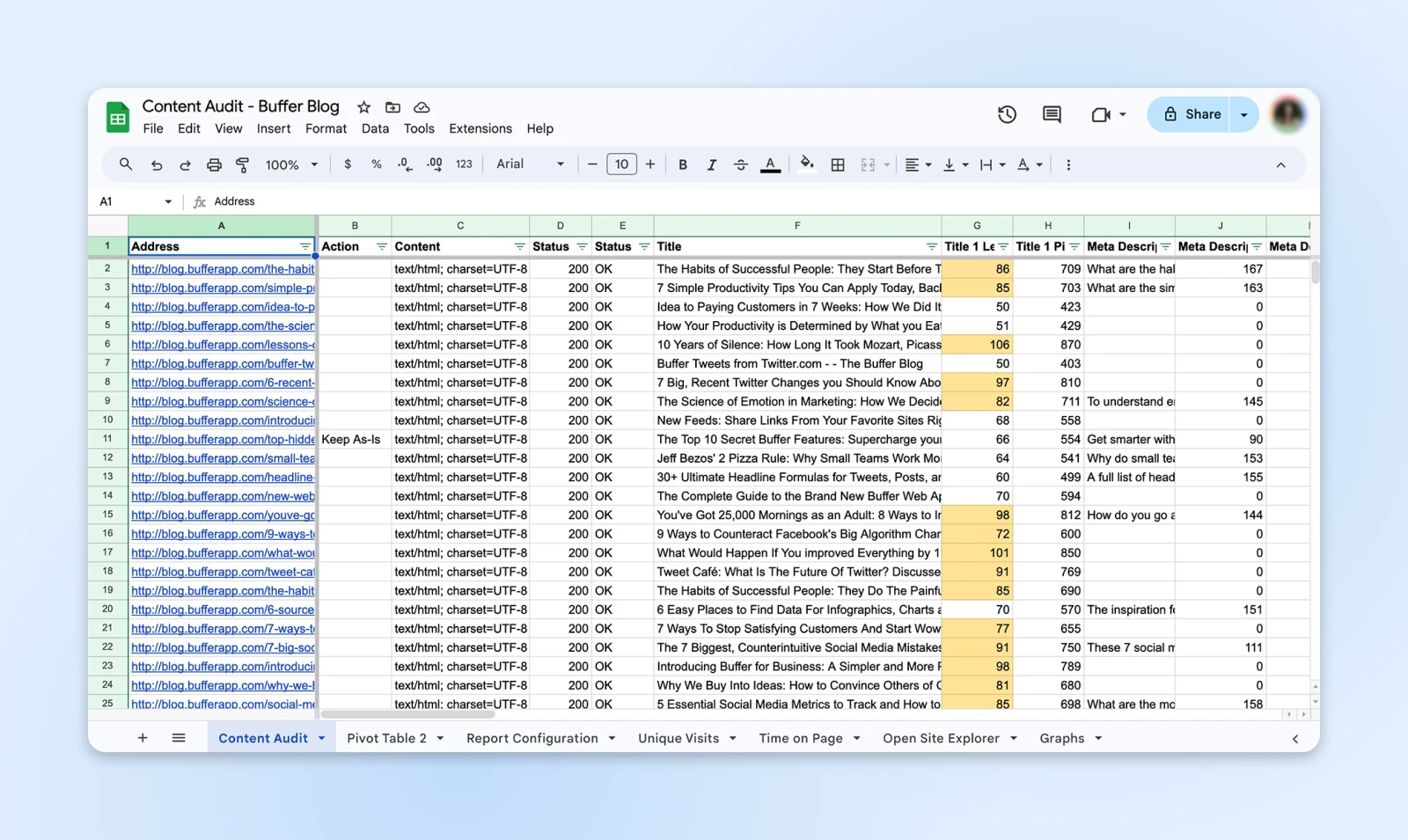
If the process of making your own spreadsheet leaves you feeling overwhelmed, there are plenty of sites that offer templates to save you from doing extra work (and/or pulling your hair out):
- CoSchedule, a site known for its great marketing calendar, has a free template to use for a content audit. You have to sign up as a site member before you can access it, but the process is quick and painless
- If you’re an avid Google Sheets user, Buffer made a great one that you can use (plus a tutorial on how to quickly fill it all in using a bunch of handy content audit tools). Google Sheets was designed for sharing and multi-person editing so this template is especially handy if you need to distribute your audit among several other people.
3. Decide What Data To Collect
Now that you’ve set up and organized your spreadsheet, it’s time to dig a little deeper.
There are several indicators you can track when performing your content audit, but you also don’t want to end up with a ton of information that you’re never going to use. To avoid being bogged down with unnecessary stats, narrow your focus to one or two specific issues.
In addition to tying these back to your goals and their metrics from Step 1, here are some ideas to help you get started:
Functionality
- Are there any broken links on your site?
- Do all linked images and videos work?
- Do videos and images display properly?
- Do you have the right hosting plan for the job?
Readability
- Does your content score well on the readability scale?
- Is it aesthetically pleasing?
- Does your site have enough white space to give the reader visual breathing room?
- Are you using headings and subheadings properly?
- Do the fonts work on all browsers/devices?
- Is your content coherently organized?
Usability
- Is the content easy to navigate?
- Does your site structure make sense for users?
- Are your pages and posts mobile-friendly?
- Is your content accessible to all users?
Relevance
- Is the content engaging?
- Is it still relevant or timely?
- If it’s outdated, could the content be updated or repurposed?
- Does it resonate with your target audience?
- Does it get shares, page views, or likes?
4. Gather The Data
Congrats! You’ve completed the basics of content auditing. Not too shabby, eh?
Once you have the foundational steps done, it’s to get into the real meat of the content audit: the gathering. (Gathering data, that is.)
When it comes to gathering the data, there are several different tactics you can use:
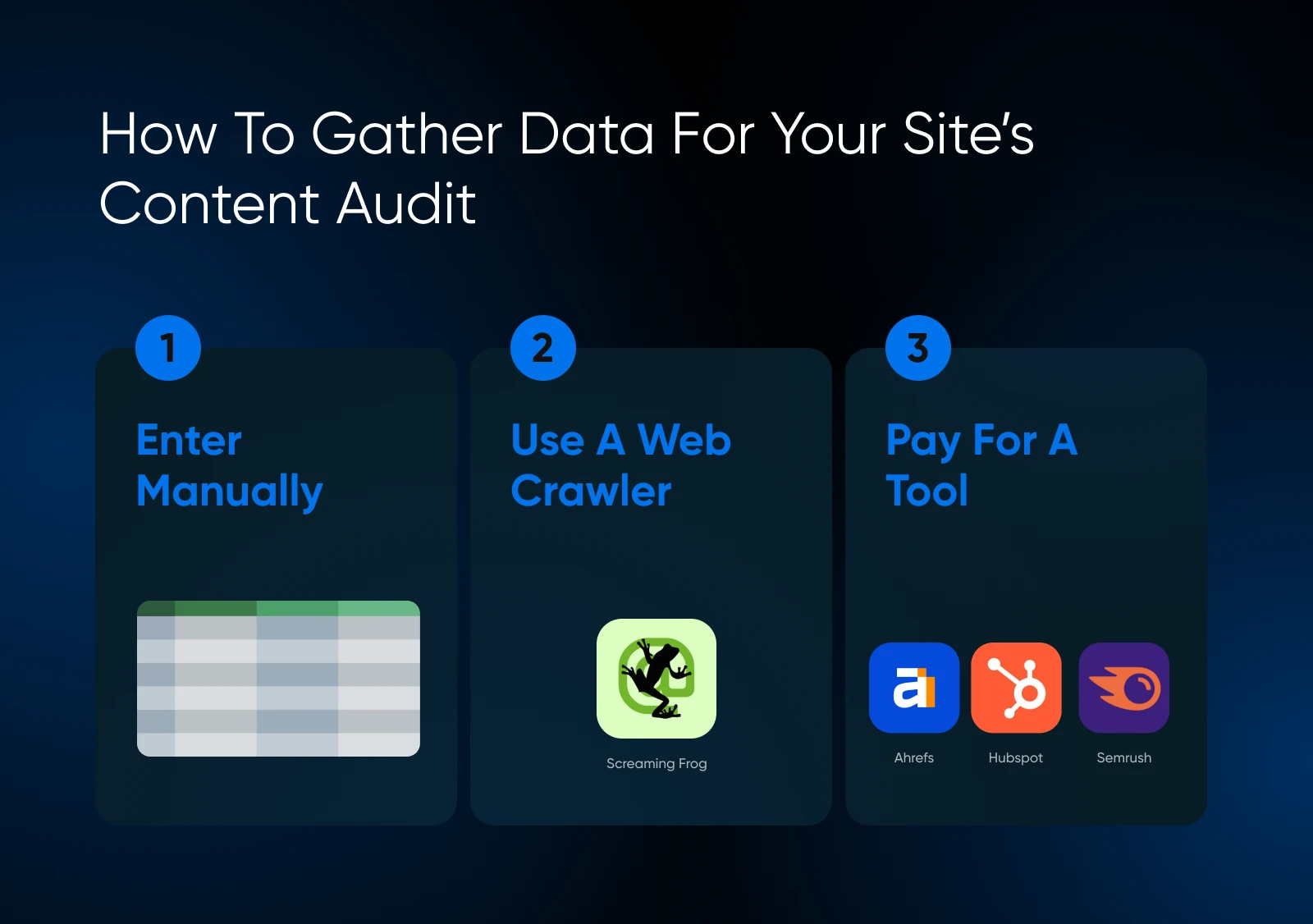
Manually Entering Data
This is the simplest method for gathering data if you have a small site. Arguably, the most important part of a content audit is getting the URLs into your spreadsheet correctly. The reason? This allows you to quickly check out that page and keep track of what changes you’ve made. Plus, if you decide to go back later and revise those changes or add to your audit, you’ll have an easy reference point.
Using A Web Crawler
If you’re working with a bigger site — think, more than a dozen or so pages — and you fear your fingers may fall off from excessive CTRL C+V, you may want to consider using a web crawler to quickly gather information.
A web crawler, such as Screaming Frog’s SEO Spider tool, is a resource that quickly filters through your site and gathers specified data. The process of using a web crawler isn’t as self-explanatory as manually entering data, but if you have a large website housing a lot of content, the time it will save would be worth the initial effort.
Here’s a sample of the information a web crawler can pull for you:
- Page URLs
- Title and title length
- Meta description and length
- Major headings
- Broken links
- Word count
Web crawlers often compress all that data into a CSV file, so you can just download it, and then add the goods to your content audit spreadsheet.
Using A Paid Tool
There are a ton of great SEO tools on the market that can help you gather this data quickly, but for the best tools, you’ll likely need to pay. Some of the most popular paid tools among content marketers include Ahrefs, Semrush, and HubSpot.
How you use each one varies a little bit, so if you’re already familiar with a particular tool, that might be your best bet. Otherwise, each tool offers a robust help section filled with tutorials. Plus, marketers have also created plenty of independent tutorials that you can search for if you need additional help.
5. Analyze Your Collected Data And Create An Action Plan
Finally, the step you’ve been waiting for — making sense of all that data! And actually doing something with the results.
Start by going back to the goals and metrics you set at the start of your audit. How did your content measure up? Which types of content performed well? Which fell short?
See which of your strategies worked, which ones weren’t as successful, and why some efforts succeeded while others seemed to flop. It should also be more apparent what content your audience resonates with.
Because you’ll need to analyze each data point, the audit can be a little time-consuming. That’s why we recommended starting small (beginners especially should only audit a few key aspects of their site), and going back later to audit and analyze what you may have missed.
As you look at the data, keep a close eye out for what content or keywords were the most successful, and which ones weren’t so hot. This will help you identify what pages, ideas, and strategies to completely nix, which ones just need slight adjustments and improvement, and which ones should serve as a model for any future content you incorporate into your site and content strategy.
Because this step requires so much scrutiny, it will be the longest step. But once you’re finished, the results will leave you praising the day you heard of the content audit.
Okay, maybe praising is a bit much, but trust us, you’ll be glad you did it. At least, the results will be rewarding if you learn from your data and create a realistic action plan, which is the next and final step!
6. Adjust Your Content Marketing Plan
After meticulously combing through your data and extracting actionable insights during your content audit, the next step is where it all comes together: adjusting your content marketing plan based on what you’ve learned.
This step is where the rubber meets the road, transforming insights into action, and theory into practice.
With your audit findings in hand, pinpoint areas for improvement. This could mean doubling down on high-performing content types, topics, or formats, as well as identifying underperforming content that can be optimized for better results. Look for opportunities not just to enhance existing content but also to fill gaps in your content library.
Next, set new goals based on your findings. For example, maybe your audit uncovered that tutorials and how-to guides drive significant engagement and conversions for your site. In that case, your new goal might be to increase production of these content types by 20% over the next quarter.
Create a prioritized list of content updates. Some content may need minor tweaks for SEO optimization, while others might require a complete overhaul to improve their relevance and accuracy. Be realistic about the timeline for these updates, considering your resources and content production capacity.
Finally, remember that content strategy is dynamic and ongoing — and this won’t be the only time you audit your content and switch gears. Stay flexible and adaptable because things will change again in the future.
Ready To Take Action?
Each website’s content audit will look different so don’t worry if you’ve done things a little differently than the Jones’. Because your site isn’t the same as anyone else’s, your action plan will also be entirely unique to you. And that’s a good thing.
A well-conducted content audit that is perfectly tailored to your site allows you to understand how best to move forward.
One way to easily interweave your action plan into the audit is to create a column in your spreadsheet titled “Action Plan” or simply “To-Do.” By doing this, each piece of content will have its own plan for the future.
This can be as detailed or simple as you’d like it to be. Extra columns can be added assigning who will carry out a certain task, deadlines, etc.
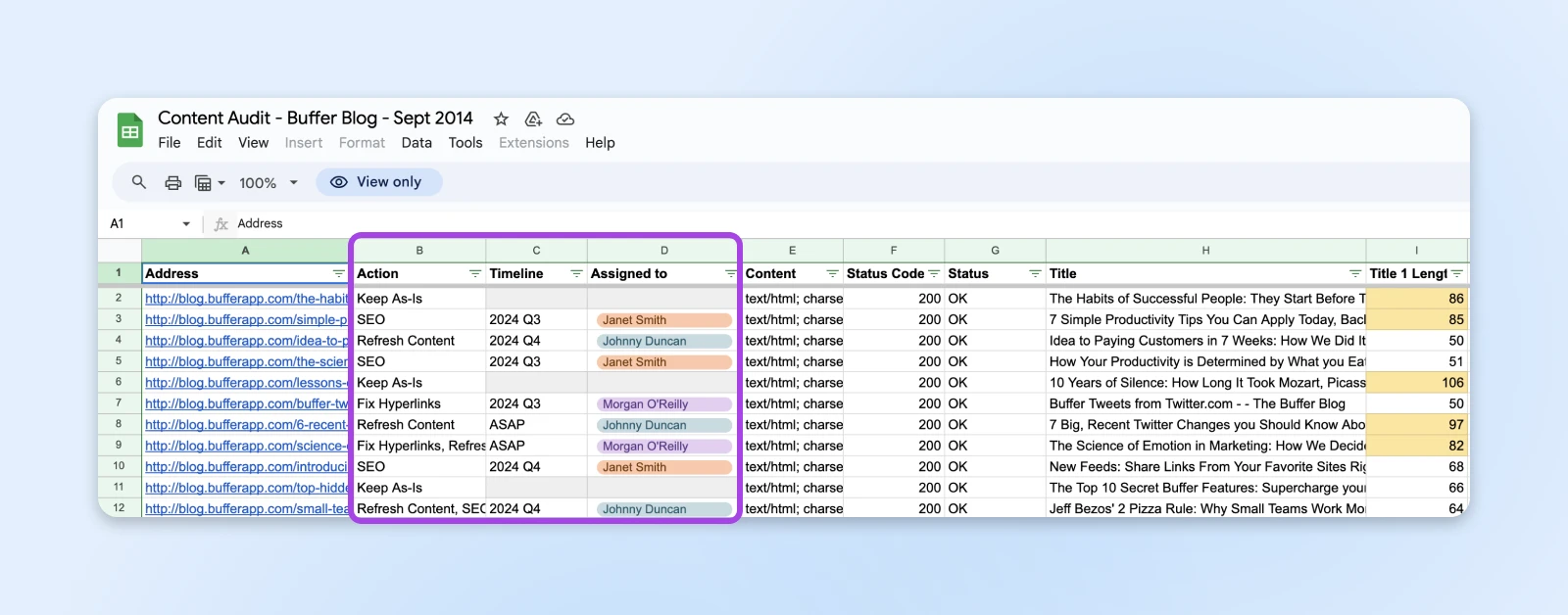
At the end of the day, how to organize your action plan is entirely up to you. You may want to create an entirely different document with a thorough outline of what actions you’ll take and when, and what you hope the results will be.
It’s your call. Our goal is to help you create something you can easily reference and understand.
Need A Content Audit Quick Fix?
First, we’ve got to tell a hard truth. No quick fix is going to provide the same results as the in-depth process we just outlined. However, we don’t want to leave anyone out in the cold (because please, we’ve had enough of that this winter).
If you run a WordPress website, you can run a content audit plugin for a quick fix. The WordPress Content Audit Plugin, for example, allows you to create a content inventory right in your WordPress dashboard — Spreadsheet not required.
You’re Finished (Sort Of)!
There you have it, folks. The dreaded content audit isn’t as bad as you thought, huh?
Once you’ve done this initial work, checking your site’s content is never going to be such a challenge again. That’s because once you’ve set up a good system, annual audits will just be a matter of adding new pages or posts to your already awesome doc.
What strategies have you used for content auditing in the past? What’s worked and what hasn’t? We’d love to hear any advice you have to make the content auditing process even more efficient. Please comment below with any tips or tricks you’ve used when auditing your site!


